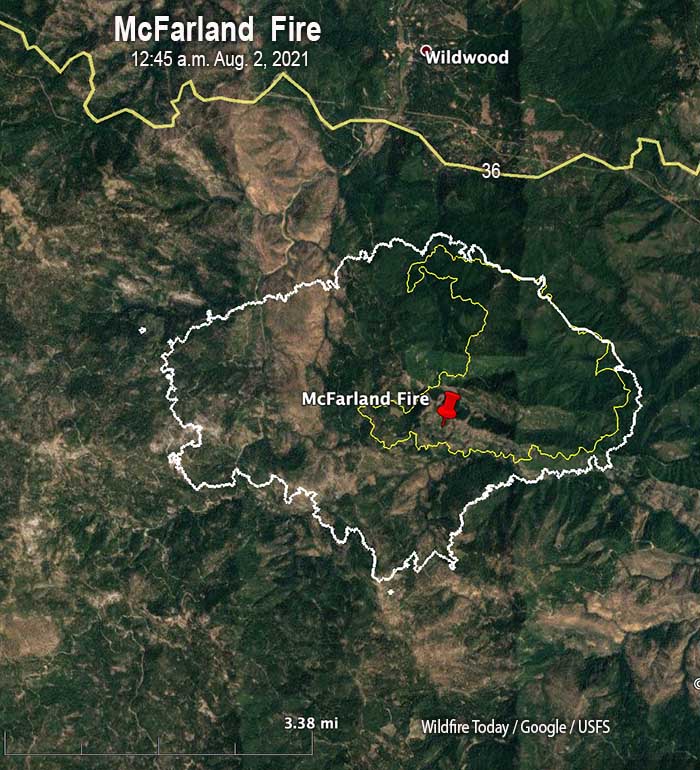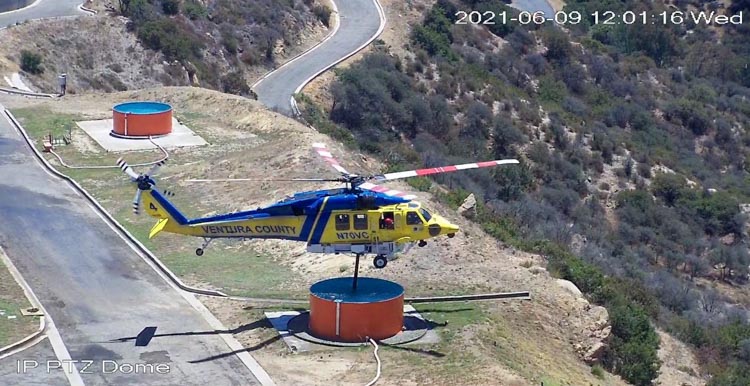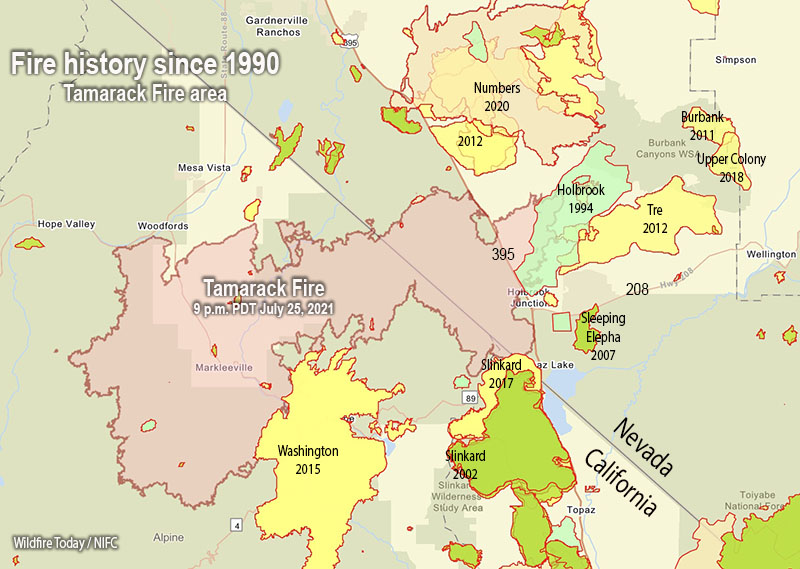1:51 p.m. PDT August 2, 2021

The McFarland Fire South of Wildwood, California burned intensely Sunday afternoon, spreading two miles to the west and a mile south. A mapping flight at 12:45 a.m. Monday showed it had consumed about 5,000 additional acres in the previous 24 hours to bring the total to approximately 7,400 acres. It moved a little closer to Highway 36 and during the flight was about three-quarters of a mile south of the highway.
The Shasta-Trinity National Forest reported on their Facebook page Monday at noon that overnight “the fire spotted three miles to the west around Hell To Find Lake.” We confirmed with FS, “A spot fire occurred three miles west of the main fire?” and they said yes.
On Monday the fire became established in the upper headwaters of Beegum Canyon, with tree torching, spotting and rollout in the steep terrain. Fixed wing air tankers made retardant drops to slow fire spread and allow ground resources the opportunity to construct containment hand lines in some areas along the fire perimeter.

The McFarland Fire is about a mile north of a large fire from 2020, the Hopkins Fire which merged with several other fires to become the Elkhorn Fire. It is a few miles south of the 2008 Telephone Fire and the 2015 Sheill Fire. Two other fires from 2008 are several miles to the east, the Gulch and Noble Fires.
A Type 2 Incident Management Team was expected assume command Sunday night.

The Monument Fire two miles west of Big Bar, California was very active Sunday afternoon spreading about a mile to the north, coming close to Highway 299, but it slowed overnight in calmer winds. A mapping flight at 12:10 a.m. Monday determined it had burned 3,114 acres, an increase of about 2,000 acres in approximately 24 hours.
Crews are focusing on building direct containment lines and assessing and preparing structures in Del Loma, Big Bar, and Pattison Ranch.
Evacuation warnings are in effect for these communities. More information can be found at the Trinity County Sheriff’s Office Facebook page.
Highway 299 has been closed intermittently due to active fire behavior and rolling material.
A Type 1 National Incident Management Organization (NIMO) Incident Management Team has been ordered for the incident.
So far, the fire is burning entirely in the footprint of the 2008 Cedar Fire, part of the Iron Complex of fires, and firefighters are opening some of the dozer lines used 13 years ago. Nine firefighters and pilots were killed when a Sikorsky S-61N helicopter crashed while working on the Iron 44 Fire that was part of that complex.
Below is a map showing the fires that have occurred in the area of these two fires, McFarland and Monument, since 2000.

7:33 p.m. PDT August 1, 2021

Lightning on July 29 started more than a half-dozen fires in Northern California’s Trinity County. As of Sunday afternoon two have burned more than 1,000 acres each and prompted evacuations. According to satellite photos and heat data from satellites Sunday afternoon both were very active. Very large smoke plumes were photographed moving north-northwest toward southwest Oregon,
Sunday morning the McFarland Fire, discovered July 31, was south of Cold Creek Road (Highway 36) a mile or two south of Wildwood, California. It is 7 air miles west of Platina, 15 miles southeast of Hayfork, and 38 miles southwest of Redding. At about 6 p.m. the Trinity County Sheriff’s office issued an evacuation order “for the town of Wildwood, CA. Evacuation areas are SR 36 @ Wildwood Road, north on Wildwood Road for 10 miles.”
At 9 a.m. Sunday the Shasta-Trinity National Forest said the McFarland Fire had burned 2,100 acres, but judging from the satellite imagery at 6 p.m. local time it likely has grown substantially since then. A Type 2 Incident Management Team will assume command Sunday night.

The Monument Fire is about 28 air miles northwest of the McFarland Fire. A mapping flight very early Sunday morning showed it was about a half mile south of Highway 299, which is now closed, and about two miles west of Big Bar. The Forest service said the fire’s movement Saturday was primarily to the east. By 2 p.m. Sunday satellite data indicated it had spread north closer to the highway.
Sunday morning the Shasta-Trinity National Forest said the Monument Fire had burned 1,000 acres, but like the McFarland Fire, it has probably also grown substantially since then.
The Trinity County Sheriff’s Office issued evacuation warnings for structures on both sides of the Trinity River near Del Loma along Highway 299 at approximately 10 p.m. Saturday night. A Type 1 National Incident Management Organization (NIMO) Incident Management Team has been ordered for the incident.








